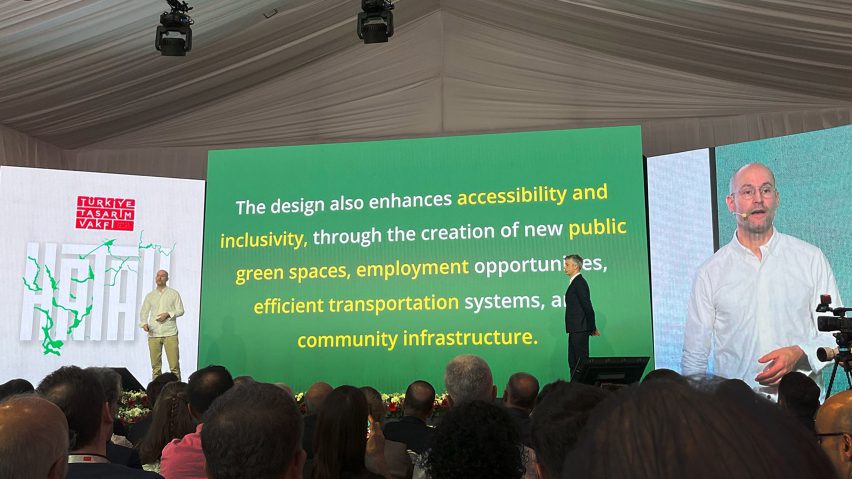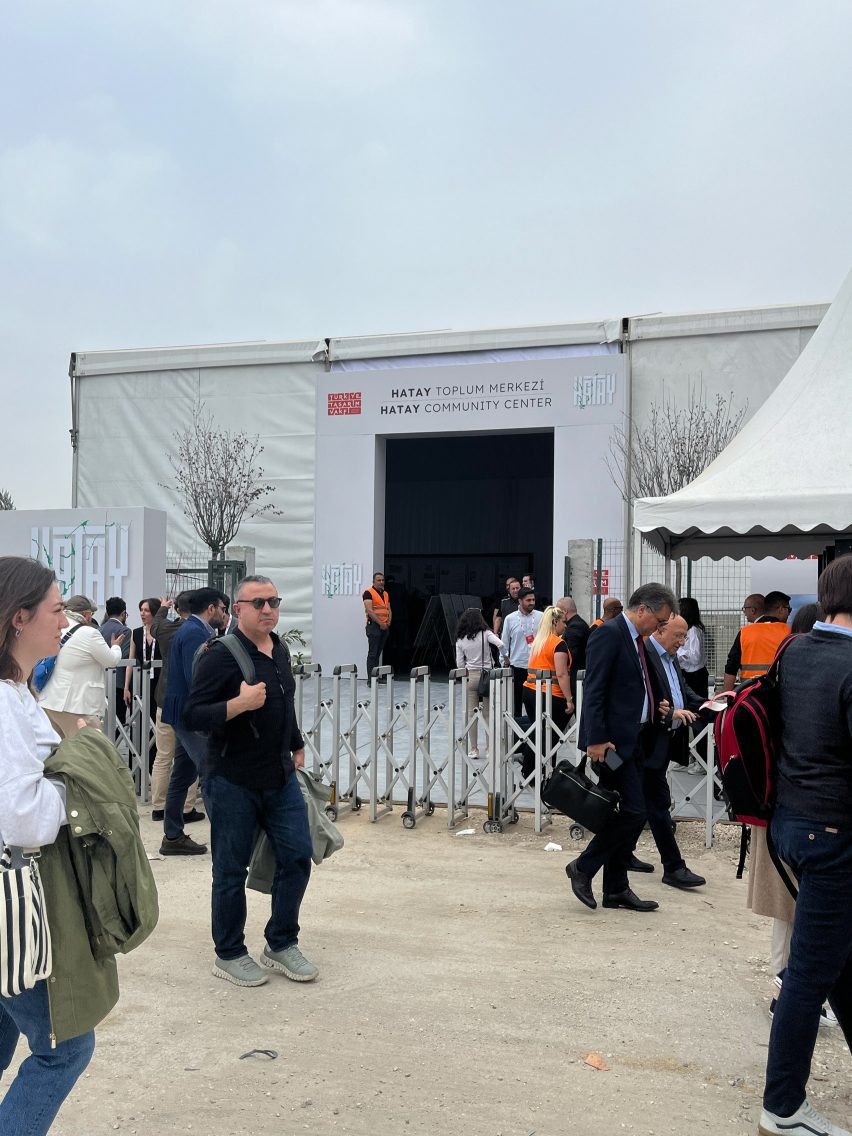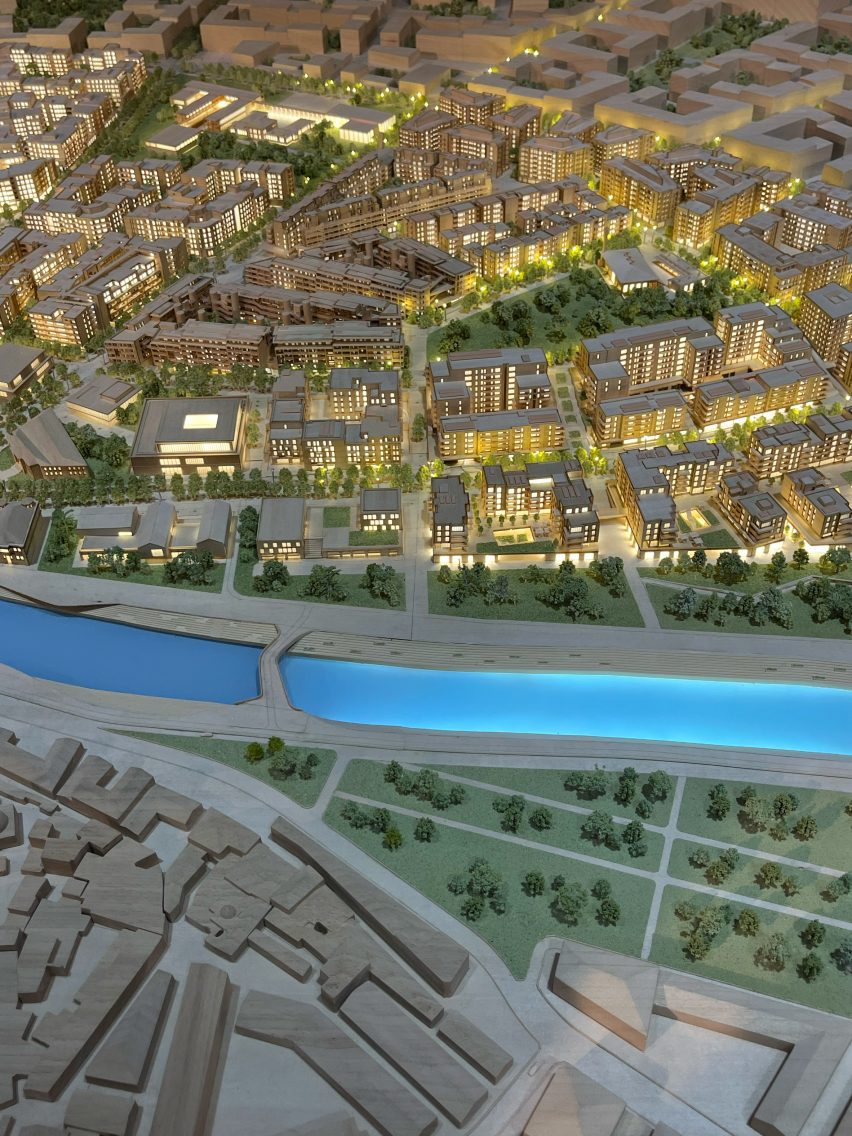Engaging with locals aids "healing" say post-earthquake ...
Involving locals in post-disaster rebuilding can aid recovery from trauma and ensure communities are effectively restored, say Foster + Partners architects designing the Antakya masterplan following the Turkey-Syria earthquakes.

"The process of being part of the rebuilding and the regrowing, healing is a big word, but I think there is something healing when you're helping to bring a place back," said head of urban design at Foster + Partners Bruno Moser.
"In terms of the psychological experience of someone who lives through trauma, there's a need to come together through the physical construction and the physical ownership of [a place], even if it's impossible to build it exactly as it was," added studio partner Nicola Scaranaro.
The architects spoke at a conference at Hatay Community CenterMoser and Scaranaro spoke to Dezeen last month following a presentation in Antakya, the capital of Hatay province, where they outlined Foster + Partners' goal for the city's rebuilding. It was held in the newly constructed Hatay Community Center.
The studio is developing the masterplan following deadly earthquakes in Turkey and Syria on 6 February 2023, which destroying cities and killed more than 50,000 people.
Foster + Partners was enlisted to lead the project by the non-governmental organisation Turkish Design Council, which is spearheading the wider recovery efforts, starting from Hatay.
Studio "borrowing from the city before"
While details about Foster + Partners' design are yet to be revealed in full, Moser and Scaranaro explained that the studio were developing it, in part, through collaborations with locals.
"As designers, the main challenge is finding that balance between replicating the old and building back to the memories, but also bringing in the best practice and the international knowledge," Moser told Dezeen.
"For us, the design is about borrowing from the city before the earthquake," he said.
Scaranaro explained that this has led the studio to develop a six-step methodology for the project that prioritises listening and working with the displaced communities to ensure a proper understanding of local needs and culture.
"To deliver the best masterplan strategies, we considered what was there before, what should be protected, and what needed to be enhanced," said Scaranaro.

"We developed a six-step methodology – learn, listen, understand, restore, improve, future-proof."
The masterplan "borrows from the city before the earthquake"As part of this, the studio set up an online platform for locals to share memories and ideas.
This has been used to develop a map-based survey offering insight into life in Antakya before the disaster, which is available as a reference for all participants in the wider project.
"We created an online platform, allowing people who are no longer present within the city to give us feedback to tell us about what they love about the city their daily lives, but also what the pressure points were and what didn't work quite so well," explained Moser.
Masterplan conscious of "sensory memory of the city"
According to Scaranaro, among the most interesting findings was that locals spoke frequently about their sensory memories of the city – particularly smells and sounds of cooking.
"Antakyans are extremely proud of their city's unique culinary traditions that blend diverse influences from Turkish, Arab and Mediterranean cuisines," explained Scaranaro.
"For many, the sensory memory of the city consciously or unconsciously revolves around the smell and sound of cooking, revealing how so many human experiences are processed through the senses," he continued.
Ensuring this can become part of the daily lives of Antakyans again will, therefore, influence the design and layouts of the masterplan, Scaranaro said.
"Our observations suggest that a spatial network of businesses, recreational areas, and neighbourhoods with socially connected shops and residences will be essential to allow life in Antakya to recover."
The concept of learning from the city pre-disaster was also influenced by Foster + Partners' research into the successes and failures of other countries forced to rebuild post-earthquake.
Many of these precedents, including Sicily, L'Aquila and Emilia Romagna, are in Italy, but the studio found some of the most successful examples to be in Japan.
From their research, the studio found that Japanese cities often rebuild post-earthquake in a way that allows people to live alongside their old neighbours and get involved in planting the new landscapes – helping communities to quickly reestablish themselves.

"We saw in certain instances where it wouldn't was not possible to rebuild in the same place because the risk was too high, they moved to a different place, but they kept the proximity," Scaranaro explained, referring to Japanese cities.
"So if you were my neighbour, you are my neighbour replace in the new place. They tend to keep the community," he said.
Alongside working with local people, Foster + Partners is also collaborating with a number of experts from across the fields of engineering, sustainability and heritage.
Among them are engineering firm Buro Happold and Danish studio BIG, as well as Turkish architecture studios including DB Architects and KEYM.
In terms of scale, the masterplan will draw on the city before the earthquake but be enhanced with modern designs and technologies, more community hubs and improved transport links.
Moser said the creation of more public green spaces and pedestrian-friendly neighbourhoods will also be a key element.
"The design borrows from the city before the earthquake, in terms of its scale and spatial structure, while striving to reinforce its local character and climate resilience," said Moser.
"The masterplan strategies promote the rebirth of a compact, walkable, greener and more resilient urban environment," he added.
"Green spaces are only a five-minute walk away and public transport and micromobility options are improved. There is also the provision of refuge spaces for future emergencies."
"There has never been an era that we lost so many cities in such a short time"
For now, Antakya and the surrounding region remain largely in ruin, with many of the displaced families living in temporary camps amongst masses of rubble.
Many Turkish architects believe that the scale of destruction caused by the 2023 earthquakes was exacerbated by poor construction and a disregard for legislation in the country.
They have called for improvements to both architectural education and practice as part of its wider recovery plan, in order to prevent history from repeating itself.
In an interview with Dezeen, the chair of the Turkey Design Council Mehmet Kalyoncu said he hopes the rebuild of Hatay can set an example for high-quality earthquake-proof construction in the country.
"Hatay will be built back starting from the centre," he said. "So if the centre will have good design, good planning and really [align] with regulations, then the rest we hope will follow that."
In the same interview, Kalyoncu added that he hopes the masterplan can serve as a blueprint for other cities having to rebuild around the world.
"There has never been an era that we lost so many cities in such a short time, we lost Beirut, we lost Aleppo and we are losing Gaza now," he explained.
"So as Turkey Design Council, as a non-governmental organisation that has lived through a recent and the most challenging experience, we want to continue in other geographies of the world."
Similary, Scaranaro hopes a lesson other cities can take is the success of listening to the needs of local people when recovering from disasters.
"Reconstruction following a natural disaster is about rebuilding trust, as well as feelings of safety and belonging," he concluded. "Learn, listen, understand, restore, improve, future-proof."
The photos are by Lizzie Crook.
Dezeen In Depth
If you enjoy reading Dezeen's interviews, opinions and features, subscribe to Dezeen In Depth. Sent on the last Friday of each month, this newsletter provides a single place to read about the design and architecture stories behind the headlines.









































